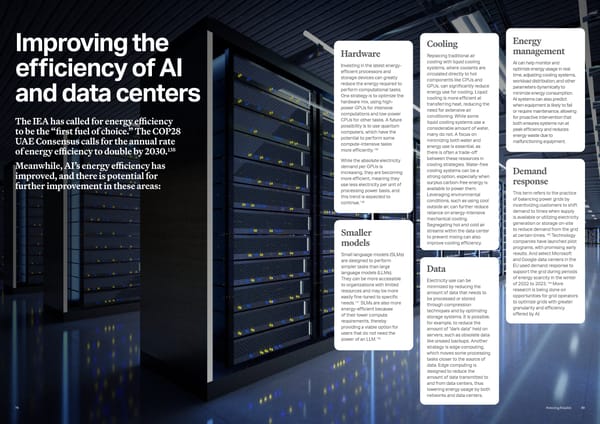Improving the efficiency of AI and data centers The IEA has called for energy efficiency to be the “first fuel of choice.” The COP28 UAE Consensus calls for the annual rate of energy efficiency to double by 2030.138 Meanwhile, AI’s energy efficiency has improved, and there is potential for further improvement in these areas: Hardware Investing in the latest energy- efficient processors and storage devices can greatly reduce the energy required to perform computational tasks. One strategy is to optimize the hardware mix, using high- power GPUs for intensive computations and low-power CPUs for other tasks. A future possibility is to use quantum computers, which have the potential to perform some compute-intensive tasks more efficiently.139 While the absolute electricity demand per GPUs is increasing, they are becoming more efficient, meaning they use less electricity per unit of processing power basis, and this trend is expected to continue.140 Data Electricity use can be minimized by reducing the amount of data that needs to be processed or stored through compression techniques and by optimizing storage systems. It is possible, for example, to reduce the amount of “dark data” held on servers, such as obsolete data like unused backups. Another strategy is edge computing, which moves some processing tasks closer to the source of data. Edge computing is designed to reduce the amount of data transmitted to and from data centers, thus lowering energy usage by both networks and data centers. Smaller models Small language models (SLMs) are designed to perform simpler tasks than large language models (LLMs). They can be more accessible to organizations with limited resources and may be more easily fine-tuned to specific needs.141 SLMs are also more energy-efficient because of their lower compute requirements, thereby providing a viable option for users that do not need the power of an LLM.142 Energy management AI can help monitor and optimize energy usage in real time, adjusting cooling systems, workload distribution, and other parameters dynamically to minimize energy consumption. AI systems can also predict when equipment is likely to fail or require maintenance, allowing for proactive intervention that both ensures systems run at peak efficiency and reduces energy waste due to malfunctioning equipment. Demand response This term refers to the practice of balancing power grids by incentivizing customers to shift demand to times when supply is available or utilizing electricity generation or storage on-site to reduce demand from the grid at certain times.143 Technology companies have launched pilot programs, with promising early results. And select Microsoft and Google data centers in the EU used demand response to support the grid during periods of energy scarcity in the winter of 2022 to 2023.144 More research is being done on opportunities for grid operators to optimize grids with greater granularity and efficiency offered by AI. Cooling Replacing traditional air cooling with liquid cooling systems, where coolants are circulated directly to hot components like CPUs and GPUs, can significantly reduce energy use for cooling. Liquid cooling is more efficient at transferring heat, reducing the need for extensive air conditioning. While some liquid cooling systems use a considerable amount of water, many do not. A focus on minimizing both water and energy use is essential, as there is often a trade-off between these resources in cooling strategies. Water-free cooling systems can be a strong option, especially when surplus carbon-free energy is available to power them. Leveraging environmental conditions, such as using cool outside air, can further reduce reliance on energy-intensive mechanical cooling. Segregating hot and cold air streams within the data center to prevent mixing can also improve cooling efficiency. 80 Powering Possible 79
 Powering Possible 2024: AI and Energy for a Sustainable Future Page 40 Page 42
Powering Possible 2024: AI and Energy for a Sustainable Future Page 40 Page 42